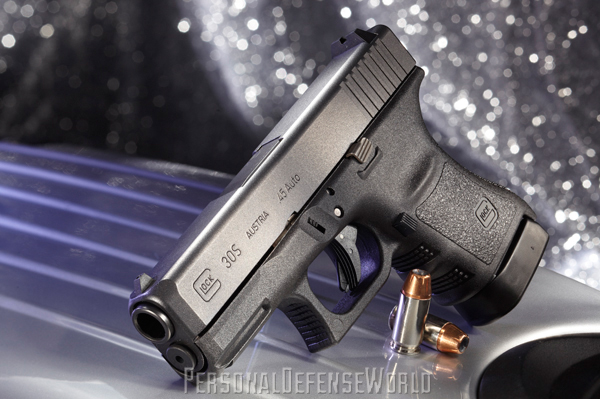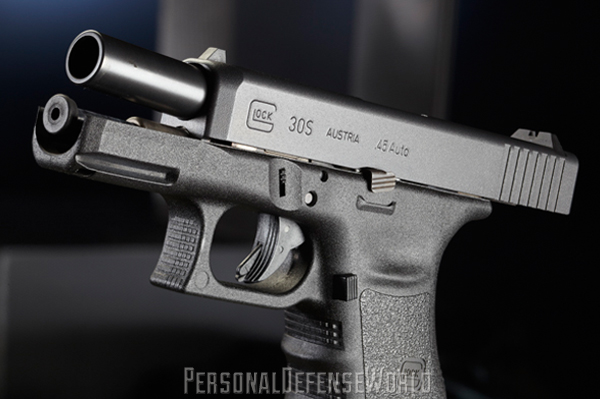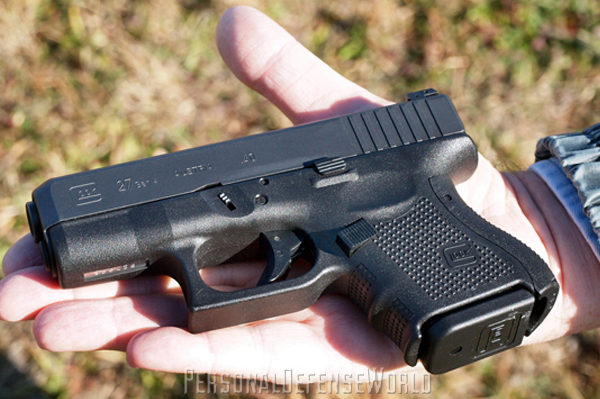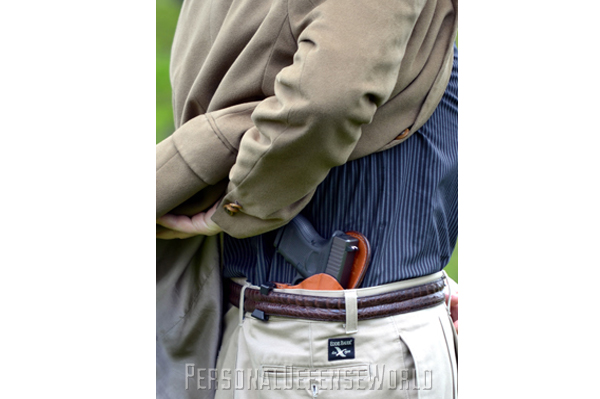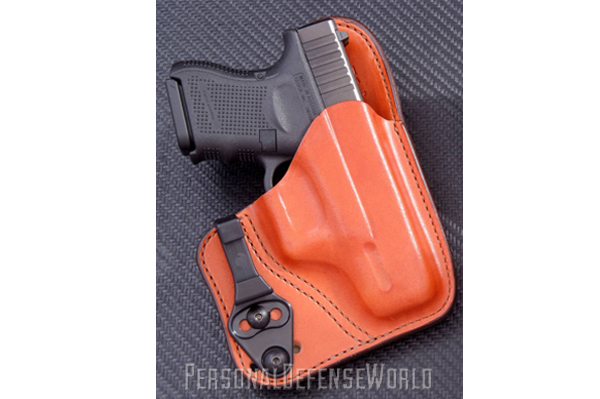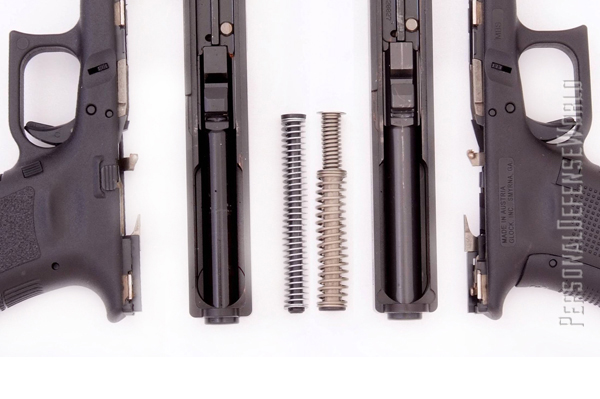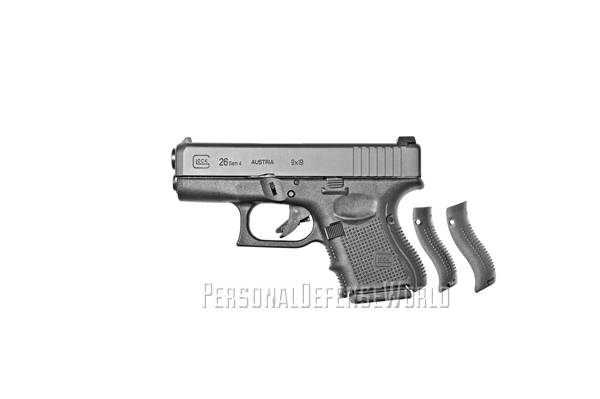Although a relatively young arms-making company, Glock has quickly taken the self-defense market by storm with its products’ enviable combination of rugged reliability, impressive performance and reasonable prices. All Glock pistols are striker-fired designs utilizing the Glock “Safe Action” system, a constant double-action design comprising of one external and two internal safeties which function automatically to prevent the pistol from discharging unless the trigger is moved rearward to the point of discharge: (1) the trigger safety (external); (2) the firing pin safety (internal); and (3) the drop safety (internal). When the trigger is pulled, the three safety features are automatically deactivated in sequence. The trigger safety blocks the trigger from being moved rearward.
The trigger safety extends through the center of the trigger face, and both must be engaged simultaneously with an average of 5.5 pounds of pull weight in order to discharge the pistol. As soon as pressure is relieved from the face of the trigger, the pistol automatically returns to its safe condition. There is no need to decock or manually activate an external manual safety, as the Glock has none. The firing pin safety prevents the Glock from discharging even if it is dropped with a chambered round. It is important to note that a Glock will fire a chambered round if the magazine has been removed.
The drop safety holds the trigger bar upward, in engagement with the firing pin, to prevent the release of the firing pin until the trigger is pulled to the rear allowing the trigger bar to clear the drop safety ledge and is deflected downward by the connector releasing the firing pin. All three safeties automatically re-engage when the slide of the pistol moves forward into battery and the trigger is released. When the slide is cycled, either to chamber the first round or when the gun is discharged, the firing pin is sent into a half-cocked “safe” position (externally, both the trigger safety and the trigger are in the forward position) and the gun can only be fired by pulling both simultaneously to disengage the firing pin safety. Any pressure on the trigger applied from a side-glancing angle, which could set off most pistols, will have no effect on a Glock.
Advertisement — Continue Reading Below
The Glock system is a very deliberate design, in theory very much the same as a double-action-only (DAO) revolver; the trigger does all the work, and no manual external safety is required. Since this is the only design that Glock makes, changing calibers, or increasing or decreasing the size of the frame or length of the barrel, makes no difference in how the gun operates. Thus, once you have become familiar with one Glock, you know how to handle any commercially available Glock model.
Pocket Models
Over the years Glock has developed companion subcompacts to match almost every standard (full-size) and compact (mid-size) model manufactured, in calibers ranging from 9mm all the way to .45 ACP. With the rapid increase in CCW (concealed carry weapon) permits over the last few years, people are looking for ultra-compact self-defense pistols.
The Austrian arms-maker initially began matching up calibers with standard-model duty guns and companion subcompacts for law enforcement use, but today an entire line of subcompact models are available chambered in the calibers 9mm (Glock 26), .40 (Glock 27), 10mm (Glock 29, Glock 29 SF), .357 (Glock 33), .45 GAP (Glock 39) and .45 ACP (Glock 30, Glock 30 SF, Glock 30S and Glock Slimline 36).
Advertisement — Continue Reading Below
The general dimensions for Glock subcompacts vary slightly by caliber and magazine capacity, generally ranging from 6.41 to 6.96 inches in overall length, 1.10 to 1.28 inches in width, and 4.17 to 4.8 inches in height, with 3.42- to 3.77-inch barrel lengths and an average empty weight of 19.33 to 24.69 ounces. The largest subcompact, chambered in hard-hitting .45 ACP, is the Glock 30, weighing 23.99 ounces empty and measuring 6.88 inches long, 4.8 inches high and 1.27 inches wide with a 3.77-inch barrel. While the Glock 30 is not as pocketable as other Glock subcompacts, it does pack 10 rounds of .45 ACP in the magazine. The latest CCW model is the new .45 ACP Glock 30S, a hybrid that combines the six-round Glock 36’s slide with the larger, 10-round Glock 30SF’s frame, thereby creating a smaller .45 autopistol without compromising capacity. The new Glock 30S has a 3.78-inch barrel, overall length of 6.88 inches, width of 1.27 inches, height of 4.8 inches and carry weight of 20.28 ounces empty. The Glock 30S, like most Glock subcompacts, is available in the Gen4 line with interchangeable backstrap panels, allowing the gun to be tailored to fit specific hand sizes or grip preferences.
Most Glock subcompacts are smaller than the Glock 30 and Glock 30S in overall dimensions, with the easiest to carry being the 9mm Glock 26, the .40 Glock 27, the .357 Glock 33 and the .45 GAP Glock 39, all measuring 6.49 inches long, 4.17 inches high and 1.18 inches wide with a 3.42-inch barrel. The majority of Glock subcompacts will fit within the open palm of the average hand, so they are small enough for pocket carry, though the average width is over an inch and will present a bit more profile in a pocket holster. The key point here is that they are small enough overall to comfortably fit in a trouser pocket.
Among the most popular concealed-carry Glock subcompacts is the 9mm Glock 26 Gen4, which offers a 10-round capacity along with the smallest frame and slide dimensions available. The Glock 26 also is one of the easiest 9mm subcompacts to shoot as the new Gen4s use Glock’s improved dual (nested) recoil spring guide-rod design to further regulate felt recoil. The 9mm is and has always been the first choice for law enforcement and military, and certainly it is today for civilians. The .40 Glock 27 Gen4 is also the same size as the Glock 26 and is favored today by law enforcement, even though in .40 the magazine only holds nine rounds versus the 9mm’s 10-round capacity.
Advertisement — Continue Reading Below
The most important choice in a concealed-carry handgun is size, and in many cases that has always been predicated on the available caliber. For Glock, this is far less of an issue since all subcompacts, regardless of caliber, are roughly the same size, so the choice really comes down to what caliber an individual is most comfortable with. Proper placement of a carry gun is essential to the wearer’s comfort, concealment and most importantly, ease of retrieval. While there are different schools of thought as to holster placement and angle, the best holster position is either at 3 o’clock at the hip or 4 o’clock just behind the hip. The latter is generally more comfortable when sitting or driving, and it makes it easier to retrieve the gun from a sitting position, and to conceal it when it’s positioned slightly further back and sheltered from view with an open coat or shirt.
When it comes to concealed carry, SOB means “small of the back.” It places the holster, usually with the gun inverted and the grips facing up, at the center of the small recess where our backs curve slightly inward. Just about everyone has this “sweet spot” above their waist, and it is here that a subcompact Glock pistol can be comfortably carried and quickly accessed when needed.
Another important part of Glock concealed carry is spare magazines. Glock offers an ambidextrous, polymer magazine pouch that features an internal detent to provide retention of the magazine without the need for a safety strap or flap, making retrieval faster. There are also a number of standard leather belt magazine pouches available. Lastly there is the sighting. All Glock subcompacts come with easy-to-acquire white-outline sights, making the question of target acquisition one of fundamental practice, not of having to get used to small or difficult-to-pick-up sights, as is the case with many pocket pistols.
For more information, visit us.glock.com or call 770-432-1202.
Advertisement — Continue Reading Below
